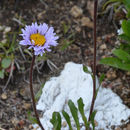en
names in breadcrumbs


Specimen citations by A. Cronquist (1947) for Erigeron grandiflorus were mostly from collections of the species treated here as E. porsildii. He also cited two collections from southwestern Alberta; those and the type collection of E. grandiflorus (from the same region) are disjunct by more than 1500 kilometers from the more northern range of E. porsildii and instead lie at the northern extremity of the range of what previously has generally been identified as E. simplex.
Erigeron grandiflorus is a North American species of flowering plant in the family Asteraceae known by the common names Rocky Mountain alpine fleabane[3] and largeflower fleabane.[4]
Erigeron grandiflorus is native to the Rocky Mountains and other nearby mountain ranges of western Canada and the western United States, from Alberta and British Columbia south to New Mexico and Arizona.[3][5] It grows in meadows, rocky areas, and near timberline.[3]
Erigeron grandiflorus is a perennial herb up to 25 cm (10 inches) tall, spreading by means of underground rhizomes. The plant generally produces only one flower heads per stem. Each head contains as many as 130 blue, pink, white, or purple ray florets surrounding numerous yellow disc florets.[3][6][7]
Erigeron grandiflorus is a North American species of flowering plant in the family Asteraceae known by the common names Rocky Mountain alpine fleabane and largeflower fleabane.
Erigeron grandiflorus is native to the Rocky Mountains and other nearby mountain ranges of western Canada and the western United States, from Alberta and British Columbia south to New Mexico and Arizona. It grows in meadows, rocky areas, and near timberline.
Erigeron grandiflorus is a perennial herb up to 25 cm (10 inches) tall, spreading by means of underground rhizomes. The plant generally produces only one flower heads per stem. Each head contains as many as 130 blue, pink, white, or purple ray florets surrounding numerous yellow disc florets.